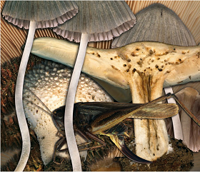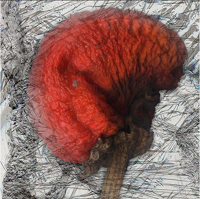 Introduction
Introduction |
Scanography by Marsha Tudor |
Scanography by Christian Staebler |
Contacts, links & resources
|
|
Introduction
Scanography, also spelled Scannography and referred to as Scanner Art or Scanner Photography is the name for a process to create digital images using a flatbed scanner in a way the manufacturer hasn't initially planned
- a process of creating art with the scanner.
Although a scanner has a very limited capability of capturing depth of field, it is possible to scan small three-dimensional objects like flowers. The high resolution of recent film scanners allows very close macro photographies. Ordinary objects like a thin tomato slice may appear in a totally different view.
Scanography has been around almost as long as scanners themselves. Many artists have developed their very individual techniques of creating art with a scanner.
|

(Please click to enlarge)
|
|
|
|
|

(Please click to enlarge)
|
Equipement & Techniques
Any computer and flatbed scanner combination is able to produce great scanographies. The usage of a high resolution photo scanner with a large flatbed of cause allows to scale up the images far more as it is possible with a simple document scanner. SilverFast is the ideal software choice to ensure true colors and comfortable scanning.
There are many different techniques for creating scanner art, many scanographers have developed their own styles. Some arrange a complete composition of many objects directly on the flatbed, where others scan single items for arranging them with an image editor. Some artists do a lot of afterward image editing, where others prefer to leave the images as they come out of the scanner. Older 3-pass devices allow to influence the colors by changing the lightning between the single scans. Unlike digital cameras scanners capture the image with a one-dimensional sensor that moves in the second dimension. This process affords some time, where the objects on the flatbed can be moved for creating some very special effects.
|
Introduction |
Scanography by Marsha Tudor |
Scanography by Christian Staebler |
Contacts, links & resources
|
 Introduction |
Scanography by Marsha Tudor |
Scanography by Christian Staebler |
Contacts, links & resources
Introduction |
Scanography by Marsha Tudor |
Scanography by Christian Staebler |
Contacts, links & resources
 Introduction |
Scanography by Marsha Tudor |
Scanography by Christian Staebler |
Contacts, links & resources
Introduction |
Scanography by Marsha Tudor |
Scanography by Christian Staebler |
Contacts, links & resources